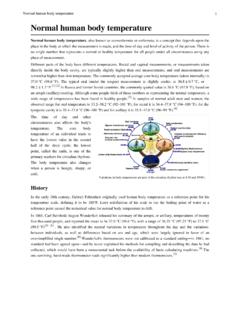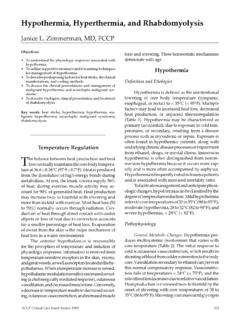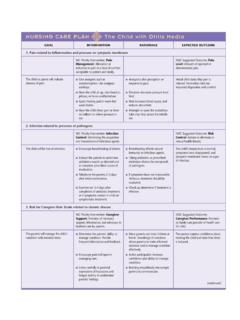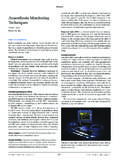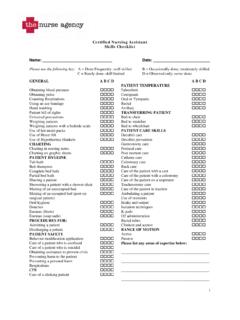Transcription of The use of infra-red (tympanic) temperature as a guide to ...
1 Prepared by the Institute for Occupational Medicine for the Health and Safety Executive 2013 Health and Safety ExecutiveThe use of infra-red ( tympanic ) temperature as a guide to signs of heat stress in industryRR989 Research ReportRichard Graveling, Laura MacCalman and Hilary Cowie Institute for Occupational Medicine Research Avenue North Riccarton Edinburgh EH14 4 APPrevious IOM research, showed that the use of a simple infra-red (IR) ear thermometer did not provide a reliable prediction of core body temperature for use in industrial situations (Graveling et al, 2009). The aim of this research was to explore the use of an IR ear thermometer further, and to determine whether the consistency and accuracy of the measurements obtained could be improved sufficiently to provide a reliable indication of the risk of an individual suffering from heat studies where IR temperature has been compared with core temperature benchmarks such as rectal temperature to provide further detail on likely sources of variation in measured tympanic temperature were re-examined.
2 Based upon the factors identified, a number of experimental studies were carried out to explore the influence of these factors, together with revised measurement methods aimed at reducing their results showed that the technique devised as a result of these studies did give more reliable results than those found previously although the predictive relationship determined showed that IR tympanic temperature could still not be used to predict actual core body temperature with a sufficient degree of accuracy for it to be used in industry. However it is suggested that this provides a possible basis for the use of IR thermometry as a screening tool in monitoring hot workplaces for possible risks of thermal report and the work it describes were funded by the Health and Safety Executive (HSE). Its contents, including any opinions and/or conclusions expressed, are those of the authors alone and do not necessarily reflect HSE use of infra-red ( tympanic ) temperature as a guide to signs of heat stress in industryHSE BooksHealth and Safety Executive Crown copyright 2013 First published 2013 You may reuse this information (not including logos) free of charge in any format or medium, under the terms of the Open Government Licence.
3 To view the licence visit , write to the Information Policy Team, The National Archives, Kew, London TW9 4DU, or email images and illustrations may not be owned by the Crown so cannot be reproduced without permission of the copyright owner. Enquiries should be sent to 11 Introduction 22 References to measurement technique in the literature 33 Further laboratory studies 74 Discussion 265 Conclusions 32 References 33 Appendix 1 35 1 Summary Previous IOM research, showed that the use of a simple infra-red (IR) ear thermometer did not provide a reliable prediction of core body temperature for use in industrial situations (Graveling et al, 2009). There are conflicting reports in the scientific literature with some echoing that view whilst others suggest that such thermometers can reliably be used.
4 The research reported here was carried out to explore the use of an IR ear thermometer further, and to determine whether the consistency and accuracy of the measurements obtained could be improved sufficiently to provide a reliable indication of the risk of an individual suffering from heat strain. The research re-examined the published studies where IR temperature has been compared with core temperature benchmarks such as rectal temperature to provide further detail on likely sources of variation in measured tympanic temperature . Based upon the factors identified, a number of experimental studies were carried out to explore the influence of these factors, together with revised measurement methods aimed at reducing their influence. The results showed that the technique devised as a result of these studies did give more reliable results than those found previously although the predictive relationship determined showed that IR tympanic temperature could still not be used to predict actual core body temperature with a sufficient degree of accuracy for it to be used in industry.
5 However, at an IR temperature of C approximately 85% of people would have an IG (core) temperature of between 38 C and 39 C with approximately 10% having a lower temperature and 5% a higher temperature . It is suggested that this provides a possible basis for the use of IR thermometry as a screening tool in monitoring hot workplaces for possible risks of thermal strain. However, these results were obtained from a limited number for subjects, in a restricted range of thermal environments and were obtained by a single researcher. There are indications that the technique (and therefore the results obtained) is dependent on individual technique, to the extent that the outcome depended on which ear the temperature was obtained from. The role of the make and model of thermometer also requires further investigation as the outcome varied between different instruments.
6 It remains to be seen whether the technique can reliably be applied by others, taking measurements from more people in a wider range of climates with a variety of makes and models of thermometer. 2 1 Introduction Previous IOM research, showed that the use of a simple infra-red (IR) ear thermometer did not provide a reliable prediction of core body temperature for use in industrial situations (Graveling et al, 2009). Whilst this was in agreement with some published studies ( Roth et al, 1996), others, such as Stavem et al (1997), have suggested that the technique could be used with a reasonable degree of confidence. There are many methodological differences which could possibly account for these differences in findings. For example, the study by Roth and co-workers was of marathon runners with suspected hyperthermia who had been taken into an acute medical treatment area at the event.
7 The authors do not document whether any active cooling or other treatment had been commenced but, if it had (which would seem likely) this could result in local cooling effects depressing the ear canal temperature . In contrast, Stavem and co-workers, working in a hospital setting, used the mean of readings obtained from both ears which would have reduced the influence of random measurement errors by diluting their effect. The research reported here was carried out to explore the use of an IR ear thermometer further, and to determine whether the stability and accuracy of the measurements obtained could be improved to the extent that it could be used in industry to provide a reliable indication of the risk of an individual suffering from heat strain. The research commenced with a re-examination of the published studies where IR temperature has been compared with core temperature benchmarks such as rectal temperature .
8 This was to provide further detail on likely sources of variation in measured tympanic temperature . It was anticipated that these could include operator error in inserting the temperature probe ( not pushing it fully home ); anatomical variation restricting the view of the ear drum; and a relatively narrow ear canal. There are also suggestions ( Betta et al, 1997) that different measuring instruments, employing differing technologies, can vary in their accuracy. Based upon the factors identified from this re-appraisal of the literature, a number of experimental studies were carried out to explore the influence of these factors, together with revised measurement methods aimed at reducing their influence. 3 2 References to measurement technique in the literature Introduction In order to inform attempts to improve the reliability of the measurement of tympanic temperature using an IR thermometer the literature on this measurement methodology was explored.
9 The appraisal was limited primarily to those studies identified during the previous research (Graveling et al, 2009) comparing this technique with measurements obtained from other body sites. These were supplemented by other papers identified through a search of recently published literature. The rationale for focussing on these papers was that, as the main emphasis of such papers was on the technique itself, these would be more likely to explore details of the measurement method used than, for example, a research study utilising this technique as its measure of core temperature . Review papers were excluded as they gave little detail of relevance. The findings from this overview were used to develop experimental approaches aimed at exploring the influences on the reliable measurement of tympanic temperature using an IR thermometer.
10 Descriptions of technique from the literature In many instances, the papers reviewed gave little insight into the details of the technique used. Reference was commonly simply made to the provision of prior training, usually in-house ( Jakobsson et al, 1992; Roth et al, 1996; Moran et al, 2007). In one case (Valle et al, 1999) an instructional video was used. In many papers, descriptions of the actual technique were limited to the fact that this was in accordance with the manufacturers instructions ( Modell et al, 1998; Casa et al, 2007). A subset of papers described the use of prior examination of the ear canal using an otoscope. In some instances this was to exclude those with damaged tympanic membranes or whose membrane could not be visualised ( Giuliano et al, 1999). In other cases, otoscopic examination was used to estimate the coverage of the tympanic membrane by cerumen (wax) although where this was the case ( Stavem et al, 1997; Modell et al, 1998) subsequent statistical analyses suggested that cerumen did not significantly contribute to the predictive relationship between tympanic and rectal temperatures .










